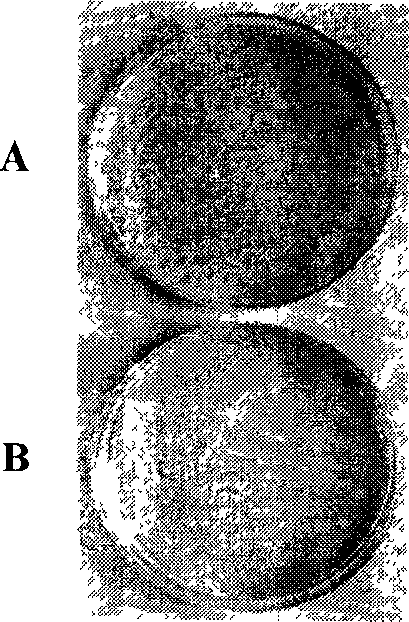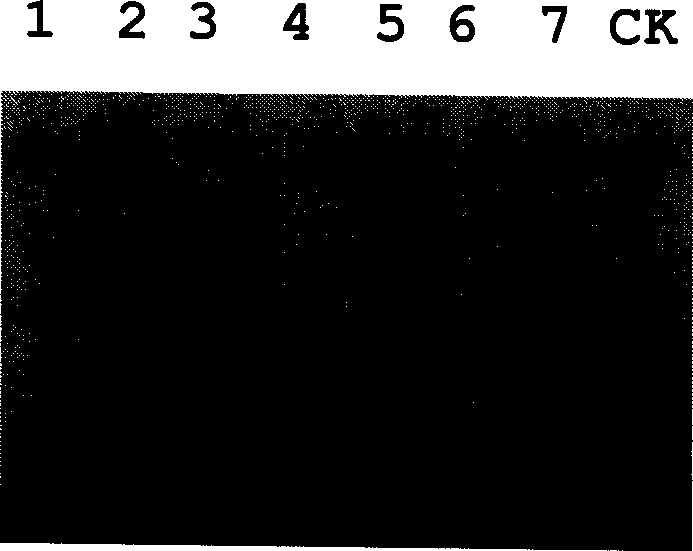Regulatory factor for anti-reverse transcription of corn, and its coding gene and application thereof
A regulatory factor and reverse transcription technology, applied in the fields of application, genetic engineering, plant gene improvement, etc., to achieve the effect of increasing yield
- Summary
- Abstract
- Description
- Claims
- Application Information
AI Technical Summary
Problems solved by technology
Method used
Image
Examples
Embodiment 1
[0034] Embodiment 1, the acquisition of LBF gene
[0035] 1. Construction of maize immature embryo cDNA library
[0036] 1. Extraction of total RNA and isolation of mRNA from immature maize embryos
[0037] Get 1g of immature embryos on the 17th day (17dpp) after pollination of maize variety Qi 319, use RNAgents Total RNAIsolation System kit (Promega Company) to extract the total RNA of the above-mentioned immature embryos of maize, then use PolyATtract mRNA Isolation System (Promega Company) from the above-mentioned mRNA was isolated from total RNA from immature maize embryos.
[0038] 2. Construction of maize 17dpp immature embryo cDNA library
[0039] Using the mRNA of maize 17dpp immature embryos obtained in step 1 as a template, use GibcoBRL's SuperScriptTMPlasmid System for cDNA Synthesis and Plasmid Cloning kit and operate strictly according to the kit instructions to construct a cDNA library of maize 17dpp immature embryos, and finally the library capacity is 5.2×10...
Embodiment 2
[0050] Embodiment 2, the binding specificity analysis of LBF and LTRE
[0051] 1. Binding specificity analysis of LBF and LTRE in yeast cells
[0052] The recombinant vectors pL4 and pmL4 were transformed into yeast yWAM2 (Leu - , His - ,Trp - ), obtain the yeast strain yWAM2 / pL4 integrated with pL4 and the yeast strain yWAM2 / pmL4 integrated with pmL4, then transform the plasmid containing the LBF gene obtained through the screening library in Example 1 into the recombinant yeast yWAM2 / pL4 and yWAM2 / pmL4, then at 28°C, in His - Cultured on selection medium for 3-5 days, the results are as follows: figure 1 As shown (A in the figure is the recombinant yeast yWAM2 / pL4, and B in the figure is the recombinant yeast yWAM2 / pmL4), only the recombinant yeast yWAM2 / pL4 can grow, but the recombinant yeast yWAM2 / pmL4 cannot grow, indicating that LBF can specifically Combined with the LTRE element, thereby activating the expression of the reporter gene HIS3 gene, so it can be expres...
Embodiment 3
[0062] Example 3, DNA core sequence analysis of LBF combined with LTRE
[0063] Site-directed mutations were performed on the possible core sequence "GCCGACC" of LTRE, and the mutation sequences of m1-m7 were as follows (underlined bases are mutation sites):
[0064] LTRE: 5'-ATTTCATG GCCGACC TGCTTTTT-3'(CK)
[0065] m1: 5'-ATTTCATG a CCGACCTGCTTTTT-3'
[0066] m2: 5'-ATTTCATGG t CGACCTGCTTTTT-3'
[0067] m3: 5'-ATTTCATGGC t GACCTGCTTTTT-3'
[0068] m4: 5'-ATTTCATGGCC a ACCTGCTTTTT-3'
[0069] m5: 5'-ATTTCATGGCCG g CCTGCTTTTT-3'
[0070] m6: 5'-ATTTCATGGCCGA t CTGCTTTTT-3'
[0071] m7: 5'-ATTTCATGGCCGAC t TGCTTTTT-3 ' carries out EMSA experiment with the method identical with embodiment 2, and the result is as follows image 3 As shown, lanes 1-7 are the combination products of LBF and m1, m2, m3, m45, m5, m6, and m7 probe sequences respectively, and lane CK is the control, indicating the combination products of LBF and LTRE probe sequences, indicating that LBF ...
PUM
 Login to View More
Login to View More Abstract
Description
Claims
Application Information
 Login to View More
Login to View More - R&D
- Intellectual Property
- Life Sciences
- Materials
- Tech Scout
- Unparalleled Data Quality
- Higher Quality Content
- 60% Fewer Hallucinations
Browse by: Latest US Patents, China's latest patents, Technical Efficacy Thesaurus, Application Domain, Technology Topic, Popular Technical Reports.
© 2025 PatSnap. All rights reserved.Legal|Privacy policy|Modern Slavery Act Transparency Statement|Sitemap|About US| Contact US: help@patsnap.com



